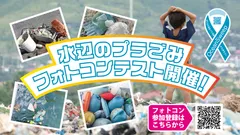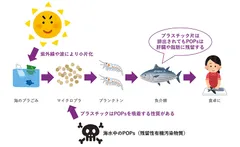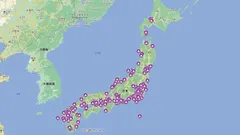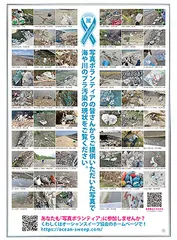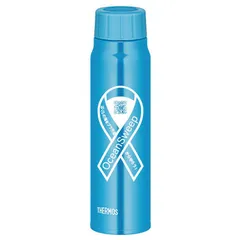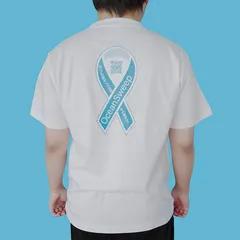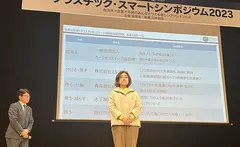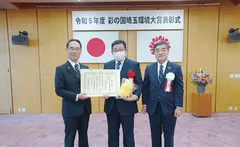SDGs Initiatives! Activities to Confront the Problem of Plastic Litter in the Oceans The "Waterfront Plastic Litter Photo Contest 2024" is now open for entries! Entries are accepted from July 20 (Sat) to August 31 (Sat).
To inform as many people as possible about the problem of plastic waste in oceans, rivers, and other bodies of water, and about the health hazards of microplastics microplastic health hazards to as many people as possible.
一般社団法人オーシャンスイープ協会
Ocean Sweep Association (Sayama City, Saitama Prefecture; President: Tomoko Yamamoto; hereinafter referred to as "the Association") (hereinafter referred to as "the Association") has been publishing the "Plastic Litter Spill Map" and exhibiting photo panels to inform the public about the status of plastic litter in the waterfront with photos in order to reduce the causes of marine plastic litter problem and microplastic health hazards. In order to reduce the amount of plastic litter, individual actions will lead to great results, so we need "convincing photos" that will move the hearts of those who see them. Therefore, we are calling for participants who volunteer to provide photos of plastic trash taken along the water's edge and their works from July 20, 2024 (Sat.) to August 31, 2024 (Sat.).
The judging committee will select three grand prize winners and seven honorable mentions from among the entries, and present them with certificates and extra prizes. Announcement will be made in mid-September 2024 by posting on the Association's website and other media.
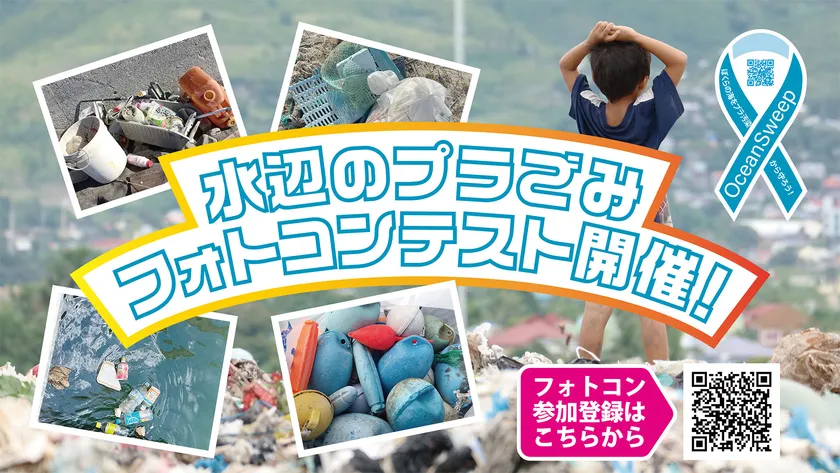
Contest title image
●What is the Plastic Waste Problem in the Sea?
https://ocean-sweep.com/issue/
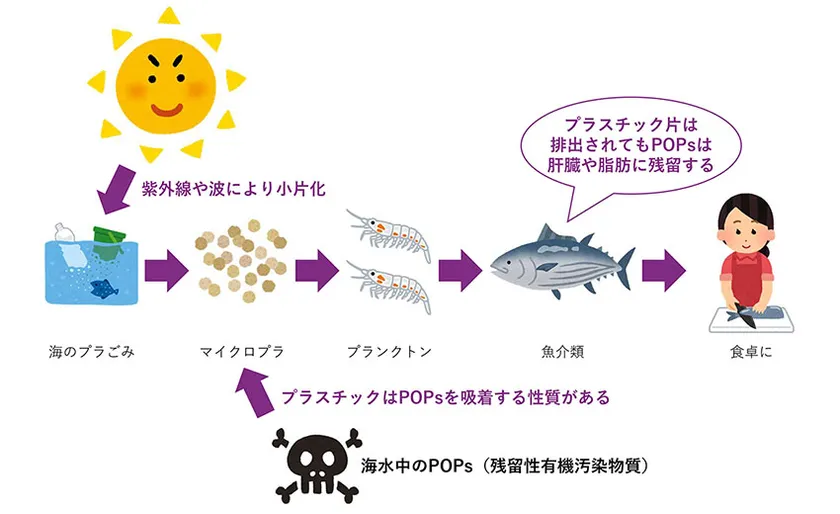
What is the Marine Plastic Waste Problem?
1) "Invisible Pollution" by Marine Plastic Litter Threatens Our Health
The molecular structure of plastic is very stable and is not decomposed by ultraviolet rays or waves, even if it is turned into small microplastics. We are all familiar with pictures of organisms dying from plastic lodged in their digestive organs, but what is more frightening is the "invisible pollution" that tiny micro-plastics (nano-plastics) carry into our bodies. The invisible pollutants are POPs (Persistent Organic Pollutants), which are said to cause breast cancer and reproductive abnormalities, etc. Some are present in plastics from the time of manufacture, while others can be concentrated to 100,000 to 1 million times the concentration in seawater due to the plastic's ability to adsorb toxic substances in water. 1) Microplastics in the ocean around Japan
2) The concentration of microplastics in the seas around Japan is 27 times higher than the average of all oceans!
According to a survey of microplastics conducted between 2014 and 2016 by a research team led by Professor Atsuhiko Isobe of Kyushu University and commissioned by the Ministry of the Environment, the amount of microplastics in the waters surrounding Japan, where the Kuroshio Current flows in from countries with large amounts of plastic waste discharge, is 27 times higher than the average for oceans worldwide. The amount of microplastics was 27 times higher than the average value of the world's oceans.
3) The amount will triple by 2030 and quadruple by 2060! Neglect is not the status quo.
As the amount of plastic used increases year by year, illegal dumping also increases, and the amount of marine plastic waste that flows from land into the ocean is rapidly increasing, now amounting to 8 million tons per year worldwide (from the Environmental White Paper and WWF Japan website).
If the current situation continues, it is predicted that by 2030 the weight concentration in the upper ocean around Japan and in the central North Pacific will double from 2016 levels, and by 2060 it will quadruple (from the website of the Isobe Laboratory, Kyushu University), so doing nothing will not maintain the current situation, but will only make it worse.
4) More than half of marine plastic waste is household waste, and no one is a stranger to it.
For example, field studies have pointed out that plastic bottles spilled from outdoor trash cans are carried away by wind and rain and end up in rivers. If each consumer checks himself/herself to see if there are any lifestyle habits that cause marine plastic waste, and improves where improvements are needed, we can reduce the amount of plastic waste that flows into the ocean through rivers and irrigation canals.
Of the marine plastic waste, 51% is household waste, 34% is fishery waste, and 15% is waste from agriculture and industry (data from the Ministry of the Environment and the Aichi Prefecture Coastal Debris Environmental Study Site). Since more than half of marine litter is household waste originating from the city and no one is a stranger to it, the source of the outflow cannot be closed unless lifestyle habits that curb the generation of plastic litter become widespread.

Image of plastic waste discharge map
● How to solve the problem of marine plastic waste
In order to solve the problem of marine plastic waste, two approaches are necessary: "collection" of plastic waste that has already flowed out and "deterrence" to prevent the flow. In particular, the deterrence of plastic waste is greatly affected by the lifestyle habits of each consumer, such as what and how they use plastic and what they do when they throw it away.
Purpose of the Photo Contest
The purpose of the photo contest is to show how much plastic waste is floating in the oceans, ports, and rivers around the country, not only through statistical figures but also through realistic visuals, and to help many people become more interested in the problem of marine plastic waste. For this purpose, the submitted photos will be published on the "Plastic Waste Discharge Map" on the Internet operated by our group and on display panels rented to local governments, schools, etc. for public viewing.
Plastic Waste Discharge Map
https://www.google.com/maps/d/edit?hl=ja&mid=1XNK19S6Cuqbq7NnIhcYj7GquK00W66IG&ll
Outline of the Photo Contest
Judging Criteria
Entry photos will be judged based on the following criteria.
The photos will be judged on the basis of the following criteria: ・Is the photo inspiring enough to move viewers to take action to address the plastic waste problem?
How to Participate】 Please apply for participation using the following entry form provided by the Association.
Please apply for participation using the application form provided by the Association. We will reply with guidance on how to send photos and the address to which they should be sent. The application guidelines are also included in the application form.
Application form (Google Form)
https://forms.gle/VmLpAvkoFYrhwyLw9
Supplementary Prizes and Method of Announcement
The winners of the Grand Prize or Encouragement Prize will receive the following extra prizes. The winners will be announced in mid-September 2024 on our website.
Grand Prize (3 winners): Stainless steel thermal bottle
Encouragement Prize (7 winners): 100% cotton T-shirts
Entry Period
The entry period for the photo contest is from Saturday, July 20, 2024 (0:00) to Saturday, August 31, 2024 (23:59).
Issuance of Certificate of Activity
If you need a certificate of activity, please request it again when you send us your photo, as we will issue it after you send us your photo.
If you have registered using a nickname or other nickname, please provide your real name.
Please note that we will issue the activity certificate within 48 hours of receiving your photo, unless there is a special timing, such as during an event or an official vacation period at the office.
In addition, as a general rule, one certificate will be issued for each day of the activity.
Please note
Please read the application guidelines on the application form carefully before participating, and take sufficient care to ensure safety at your own risk so as not to disturb residents in the neighborhood, as our group cannot be held responsible for any accidents or problems that may occur.
About Ocean Sweep Association
<Our slogan
Protect our oceans from plastic pollution!
<Proposition (Purpose)
Ocean Sweep Association is a nonprofit organization with the slogan "Let's protect our oceans from plastic pollution! Ocean Sweep Association is a general incorporated association that promotes the "Ocean Ribbon Movement" with the slogan "Protect Our Oceans from Plastic Pollution!
The Ocean Ribbon Movement protects marine life and marine products from microplastic pollution by sharing information about plastic pollution in the ocean with society through videos and photos, increasing the number of people and companies working to reduce plastic waste generation, and promoting social implementation of a system for collecting and disposing of plastic waste from the ocean.
The organization is a nonprofit organization that promotes the protection of marine life and marine products from microplastic pollution.
<Organization Profile
Organization: Ocean Sweep Assoc.
Location: 1083-3 Nakashinden, Sayama-shi, Saitama 350-1311
Representative: Tomoko Yamamoto, President
Establishment: February 22, 2021
- Category:
- Announcements & Recruitment
- Genres:
- Nature & Ecology Education Society(Japan)
